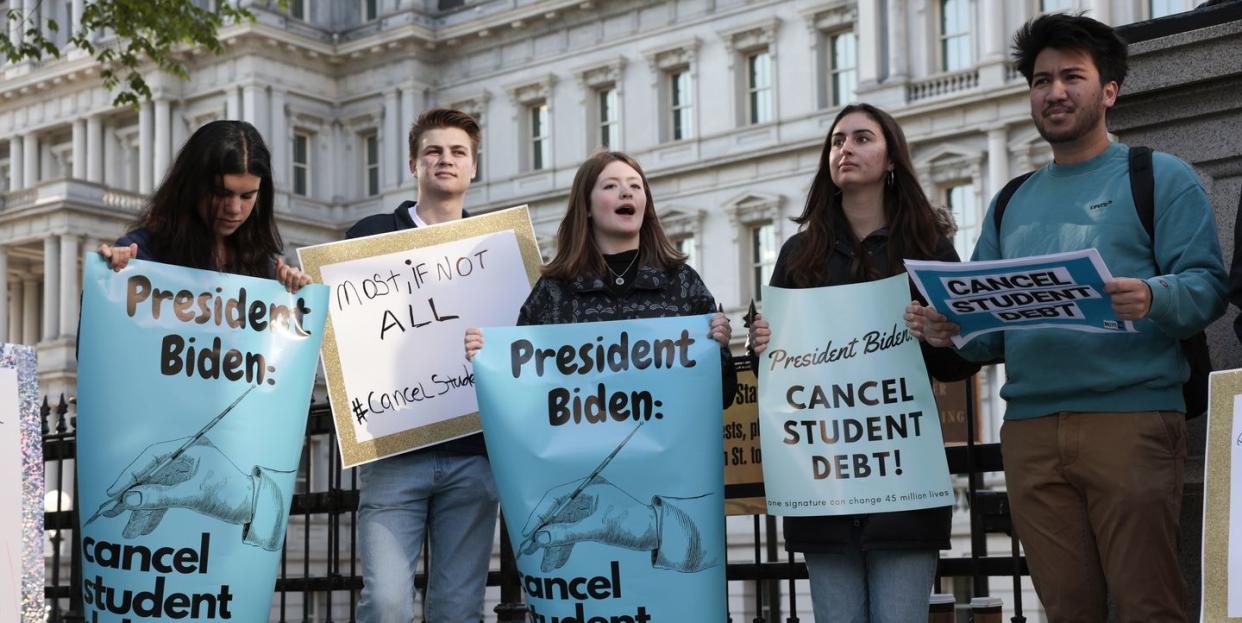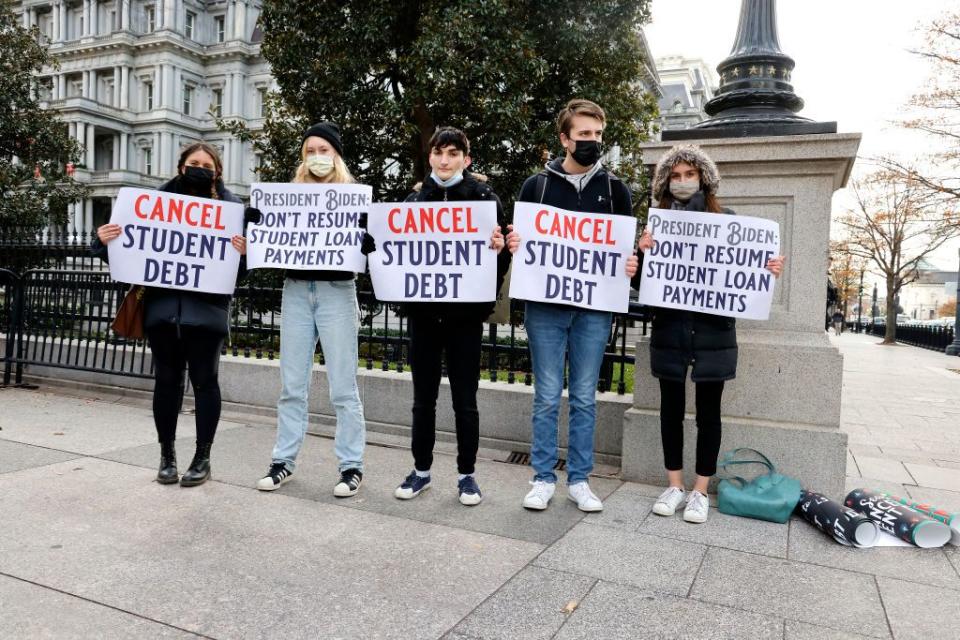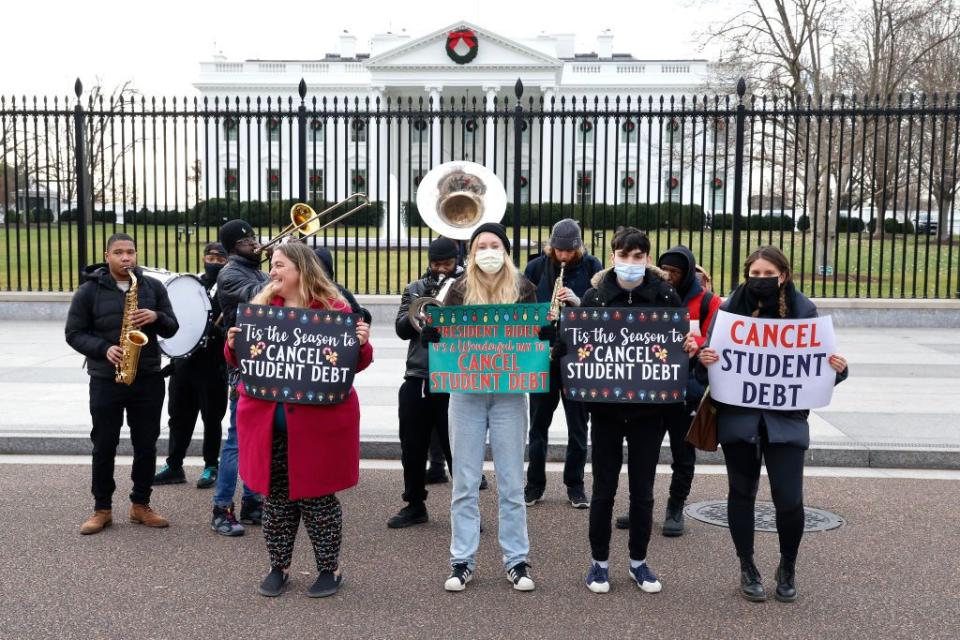The Biden Administration Extends the Student Loan Payment Pause Once Again

- Oops!Something went wrong.Please try again later.
When President Joe Biden officially entered the White House, one of his most anticipated initiatives surrounded student loan forgiveness. On the campaign trail, he made promising statements about college debt and pledged to forgive some amount of federal student loan debt for borrowers. As of August 2022, Biden has cancelled around $32 billion in debt for select groups, and now, he’s announced that he’s canceling up to $10,000 in student loan debt for those who make less than $125,000 a year, and up to $20,000 for those who were Pell Grant recipients and make less than $125,000 a year.
Due to the financial strain of the pandemic, payments have been in forbearance since March 2020, meaning borrowers have been able to temporarily stop payments or make smaller payments for over two years. The payment pause has been extended once more through June 2023, according to CNBC.
As the administration’s forgiveness plan rolls out, and payments are set to restart in about seven months, here’s everything you need to know about Biden’s federal student loan policy, what he has enacted so far, and how his forgiveness policy affects you.

So, how many people are affected by student loan debt?
It’s estimated by the Federal Reserve that national student loan debt reached over $1.7 trillion in the second quarter of 2021. That means around 43 million student borrowers are in debt, per statistics from the Education Data Initiative.
What does Biden’s August 24 executive order on loan forgiveness mean?
On Wednesday, August 24, President Biden announced that he’d be cancelling up to $10,000 in federal student loan debt for borrowers who make less than $125,000 a year. For those who received a Pell Grant — a form of federal financial aid — and make less than $125,000 a year, up to $20,000 in student loan debt will be forgiven. Private loans are not eligible for forgiveness.
On September 29, the administration scaled back eligibility for some borrowers, per CNBC, as six states sued Biden over his forgiveness plan. Borrowers with Federal Family Education Loans (FFEL) or Perkins loans not held by the U.S. Department of Education no longer qualify for relief, unless they applied for consolidation before September 29. (Consolidation allows you to combine multiple loans into one.) According to CNBC, this reversal affects about 770,000 borrowers.
However, the debt relief plan has repeatedly been blocked in court. In November 2022, a federal appeals court in St. Louis, Missouri, placed a nationwide injunction on the plan, according to CNBC, which prevents the program from taking effect.
Biden’s plan also caps monthly payments for undergraduate loans at 5 percent of a borrower’s income, down from 10 percent.
How do I apply for loan forgiveness?
The Department of Education has set up an application for qualified borrowers. On Monday, October 17, the student loan forgiveness application formally launched. You can find it here. You’ll need to input your first and last name, your Social Security Number, your date of birth, your phone number, and your email. No other supporting documents are required. Once completed, the Department of Education will review, determine if you’re eligible for forgiveness, and then consult with your loan servicer to set the relief process in motion. The application will close on December 31, 2023.
A few days earlier, a beta website — meant to pinpoint and fix any potential glitches — opened for borrowers. According to CNN, anyone that submitted their application on the beta site does not need to reapply.
“Those borrowers will not need to reapply if they submit their application during the beta test, but no applications will be processed until the site officially launches later this month,” a Department of Education spokesperson previously told CNN. “This testing period will allow the Department to monitor site performance through real-world use, test the site ahead of the official application launch, refine processes, and uncover any possible bugs prior to official launch.”
It’s also a good idea to double-check all of your personal and contact information on your loan servicer’s website, and keep an eye out for any communication or guidance from them.
How can I avoid student loan forgiveness scams?
Since the announcement of the student loan forgiveness plan and the launch of the application, Biden has warned borrowers of scam attempts, per a press release from the White House. These might include texts or calls from scammers, claiming that you qualify for loan forgiveness and that you need to provide personal information and/or payment quickly before the offer expires. The Department of Education affirms that you should never pay anyone who promises student loan forgiveness. “YOU DO NOT NEED TO PAY ANYONE TO OBTAIN DEBT RELIEF,” the Education Department wrote in a blog post on October 5. The student loan forgiveness application is free on the Department’s website.
There are other ways to protect yourself from student loan forgiveness scams. “DON’T reveal your FSA ID or account information or password to anyone who contacts you. The Department of Education and your federal student loan servicer will never call or email you asking for this information,” the Department wrote.
Further, never give your financial or personal information to an unknown caller. If you’re unsure, call your loan servicer directly. You can find your servicer at studentaid.gov and report fraudulent calls here.
“DON’T refinance your federal student loans unless you know the risks,” the Department of Education adds. “If you refinance federal student loans that are eligible for debt relief into a private loan, you will lose out on important benefits like one-time debt relief and flexible repayment plans for federal loans.”
To best access accurate, secure information on your loans and federal student aid, make sure you’ve set up an account at studentaid.gov. Check that your contact information is all up to date here, and on your loan servicer’s website.
Who has Biden forgiven loans for so far?
President Biden has forgiven about $32 billion in federal student loans among the following groups: borrowers who were defrauded by their schools, borrowers with a total and permanent disability, and borrowers who work in the public sector.
The borrowers who attended now-nonexistent schools were the first to benefit from the loan forgiveness initiative. This aimed to aid those who attended a school that engaged in either illegal activity or “other misconduct in violation of certain state laws.”
The second group consisted of borrowers who were registered as having a “total and permanent” disability by the Social Security Administration.
The third and final group to receive loan relief was government and nonprofit employees. This was granted through the Public Service Loan Forgiveness (PSLF) program, which required borrowers to be employed full-time by the government or a not-for-profit organization, be enrolled in a repayment plan, and to have previously made 120 on-time payments. An overhaul to this program immediately wiped out 22,000 borrowers’ loans, according to the Education Department.
Why were federal student loan payments paused?
The extraordinary financial strain brought on by COVID-19 prompted then-President Trump to pause monthly student loan payments through September 30, 2020. It was subsequently extended a number of times and was scheduled to expire on December 31. But now, the repayment relief will continue through June 30, 2023.
“We’re extending the payment pause because it would be deeply unfair to ask borrowers to pay a debt that they wouldn’t have to pay, were it not for the baseless lawsuits brought by Republican officials and special interests,” United States Secretary of Education Miguel Cardona said in a statement on November 22, per NBC News.
The Department of Education confirms that the payment pause will be extended until 60 days after litigation is resolved. Although there is extra time, borrowers should check in with their loan servicer to ensure they are as prepared as possible to make payments in June 2023.

What do other lawmakers think?
Although Biden is delivering on his campaign promise to forgive at least $10,000 in federal student loan debt, some Democratic lawmakers such as Senator Elizabeth Warren and Senate Majority Leader Chuck Schumer, have urged the administration to increase the forgiveness policy to $50,000. Others have called on the president to completely cancel student loan debt for all. In a tweet on April 5, Senator Bernie Sanders of Vermont simply wrote, "Cancel student debt. All of it."
Cancel student debt. All of it.
— Bernie Sanders (@BernieSanders) April 5, 2022
New York Representative Alexandria Ocasio-Cortez echoed a similar sentiment and expressed on social media that repeatedly extending the pause is not the solution: "I think some folks read these extensions as savvy politics, but I don’t think those folks understand the panic and disorder it causes people to get so close to these deadlines just to extend the uncertainty. It doesn’t have the affect people think it does. We should cancel them," she wrote.
I think some folks read these extensions as savvy politics, but I don’t think those folks understand the panic and disorder it causes people to get so close to these deadlines just to extend the uncertainty. It doesn’t have the affect people think it does.
We should cancel them. https://t.co/ZvkGRwliLT— Alexandria Ocasio-Cortez (@AOC) April 5, 2022
In a letter to President Biden on December 8, 2021, Schumer, Warren, and Representative Ayanna Pressley expressed their concerns: “Prior to the COVID-19 payments pause, student loan borrowers paid an average of $393 per month toward their student loans — money that could not be spent on their families’ other needs.”
“The pause on federal student loan payments, interest, and collections has improved borrowers’ economic security, allowing them to invest in their families, save for emergencies, and pay down other debt. Restarting payments without cancelling student debt will undermine these families’ economic progress,” the letter continued.

On the other side of the aisle, Republican lawmakers resist any move towards total student loan forgiveness.
After Biden’s announcement on August 21, Senator Mitt Romney tweeted, “Biden's student loan forgiveness plan may win Democrats some votes, but it fuels inflation, foots taxpayers with other people’s financial obligations, is unfair to those who paid their own way & creates irresponsible expectations.”
In September 2021, Representatives Ted Budd, Warren Davidson, Scott Perry, and Barry Loudermilk wrote to Secretary of Education Miguel Cardona: “The law is clear: the Department does not have the legal authority to cancel student loan debt en masse… Mass cancellation of student loan debt would not only be a clear violation of the separation of powers but would also be an affront to the millions of borrowers who responsibly repaid their loan balances.”
You Might Also Like

